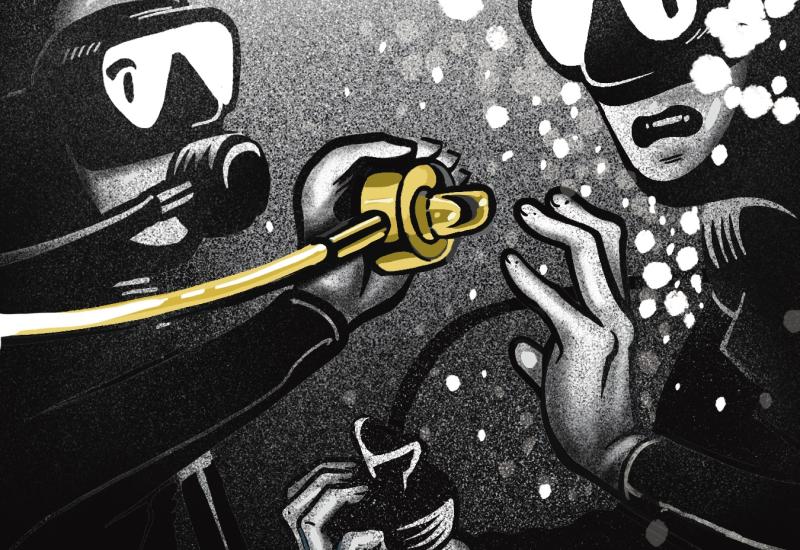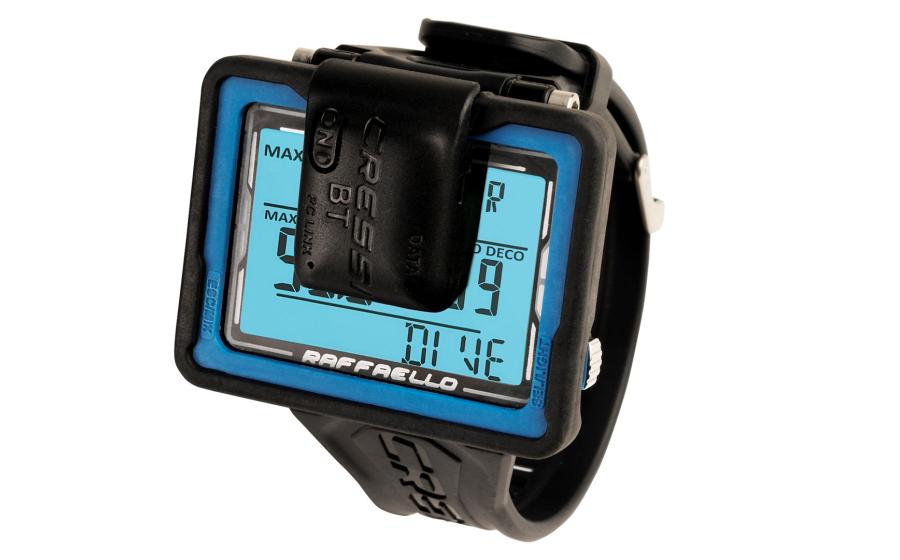Scuba Diving Lessons for Life: Planned Separation

Scuba Diving Lessons for Life: Planned Separation
Michael Morgenstern
Scuba Diving Lessons for Life: Planned Separation
Scott watched as Tiffany swam off in the direction he pointed, toward the anchor line and back to the boat. He still had a few hundred pounds of air in his tank and didn’t want to waste them. Tiffany was smaller than Scott, so she was carrying a smaller tank compared with his 90-cubic-foot cylinder. Before the dive, the pair agreed that if Tiffany reached 500 psi in the tank before Scott, she’d head back, and Scott would follow as soon as he reached the same level. Watching her swim away, Scott contemplated how happy he was that he’d managed to get his new girlfriend interested in diving.
The Divers
Tiffany was new to diving, but was doing her best to relax and enjoy it. She’d been dating Scott only a few months and knew that if she wanted to continue seeing him, she had to give scuba diving a try. Scott was an avid diver and was always telling her stories about his dive adventures. He asked Tiffany several times to get certified, so she finally got her open-water certification. While she wasn’t scared or claustrophobic, Tiffany was a little uncomfortable — especially now that they were going offshore on the dive boat. The dives they’d made together in the local quarry were straightforward, easy dives, but ocean diving made her a little nervous.
The Dive
Conditions were moderate when the dive boat left the dock on Saturday morning. Scott chatted amiably with the other divers and introduced Tiffany to his buddies, explaining that this was only her second trip offshore. Everyone on board congratulated her, but a few people noticed that she seemed a little quiet and apprehensive about the dive.
After the divemaster’s site briefing, Scott and Tiffany discussed their dive plan. Scott liked to use a larger tank on his dives, especially deeper ones. He was wearing a 90-cubic-foot tank, while Tiffany was wearing a much smaller 63-cubic-foot tank that fit her smaller frame better. Scott explained to Tiffany that her smaller lung volume would allow the air in her tank to last nearly as long as his would at the same depths. They agreed, however, that if Tiffany reached the turnaround point on her pressure gauge before Scott did, that she would swim back to the boat without him so he could finish diving on his own.
The Accident
Scott and Tiffany began their dive with a descent to 90 feet and kicked against the gentle current that was flowing across the dive site. After about 15 minutes, the pair turned the dive and headed back toward the anchor line, ascending to between 60 and 65 feet. When Tiffany checked her pressure gauge, she realized that she was running low on air, with about 500 psi left in her tank. She recognized that she’d reached the predetermined air level that would be her surfacing pressure, so she let Scott know. He signaled OK and pointed out the direction to the anchor line. Scott signaled that he had more than 500 psi and wanted to swim around a bit longer. Tiffany nodded and moved off in the direction he pointed. For a moment, Scott watched her swim away and then turned his attention back toward the dive site.
Ten minutes later, Scott finished his dive and made a three-minute safety stop at 15 feet before surfacing. When Scott boarded the boat, he discovered Tiffany wasn’t on board. Panicked, he asked whether anyone had seen her, but no one had. The crew immediately put its emergency plan into action and began a search. Tiffany’s body was found a few hours later on the bottom.
Analysis
There’s a saying in the tec and cave-diving communities that “any diver can call any dive for any reason.” That means any time divers are diving together as a buddy pair, when one diver decides the dive is over, it’s over for both divers. There’s no argument, at least underwater, and they surface together. While this credo isn’t as universal in recreational diving, it should be. In fact, the concept of staying with your buddy throughout a dive is a common one, but it is just as commonly violated.
When two divers like Scott and Tiffany are at very different skill levels, the less-experienced diver is considered to be totally dependent on the more-experienced diver. This also means, to a degree, that the more-experienced diver doesn’t have a buddy to rely on should things go wrong. We’ll never know exactly what happened to Tiffany after she and Scott split up, but she never returned to the boat. Most likely Tiffany got lost, panicked and drowned.
When Tiffany’s body was found, she was out of air and had her weights still in place. A more experienced diver like Scott could have helped her navigate back to the anchor line and the dive boat. Or, if they couldn’t find the anchor line together after a few minutes of searching, he could just as easily have helped her make a free ascent to the surface and find the boat from there. Had Tiffany and Scott simply ended the dive together, she’d likely be alive today.
Scuba Diving Lessons for Life
1. Divers paired as buddies should stay together for the entire dive. Unless each diver is trained to dive solo, and each diver is properly equipped for solo diving, both dive buddies should maintain contact throughout the dive.
2. A diver can call any dive for any reason. Do not argue about it underwater. If your dive buddy says the dive is over, stick together and surface at the same time.
3. The dive plan should take into account the skill level of each diver. Buddies should agree to surface as soon as one buddy’s tank is down to a predetermined amount of pressure (usually 500 psi).

Michael Morgenstern
Scuba Diving Lessons for Life: Planned Separation
Scott watched as Tiffany swam off in the direction he pointed, toward the anchor line and back to the boat. He still had a few hundred pounds of air in his tank and didn’t want to waste them. Tiffany was smaller than Scott, so she was carrying a smaller tank compared with his 90-cubic-foot cylinder. Before the dive, the pair agreed that if Tiffany reached 500 psi in the tank before Scott, she’d head back, and Scott would follow as soon as he reached the same level. Watching her swim away, Scott contemplated how happy he was that he’d managed to get his new girlfriend interested in diving.
The Divers
Tiffany was new to diving, but was doing her best to relax and enjoy it. She’d been dating Scott only a few months and knew that if she wanted to continue seeing him, she had to give scuba diving a try. Scott was an avid diver and was always telling her stories about his dive adventures. He asked Tiffany several times to get certified, so she finally got her open-water certification. While she wasn’t scared or claustrophobic, Tiffany was a little uncomfortable — especially now that they were going offshore on the dive boat. The dives they’d made together in the local quarry were straightforward, easy dives, but ocean diving made her a little nervous.
The Dive
Conditions were moderate when the dive boat left the dock on Saturday morning. Scott chatted amiably with the other divers and introduced Tiffany to his buddies, explaining that this was only her second trip offshore. Everyone on board congratulated her, but a few people noticed that she seemed a little quiet and apprehensive about the dive.
After the divemaster’s site briefing, Scott and Tiffany discussed their dive plan. Scott liked to use a larger tank on his dives, especially deeper ones. He was wearing a 90-cubic-foot tank, while Tiffany was wearing a much smaller 63-cubic-foot tank that fit her smaller frame better. Scott explained to Tiffany that her smaller lung volume would allow the air in her tank to last nearly as long as his would at the same depths. They agreed, however, that if Tiffany reached the turnaround point on her pressure gauge before Scott did, that she would swim back to the boat without him so he could finish diving on his own.
The Accident
Scott and Tiffany began their dive with a descent to 90 feet and kicked against the gentle current that was flowing across the dive site. After about 15 minutes, the pair turned the dive and headed back toward the anchor line, ascending to between 60 and 65 feet. When Tiffany checked her pressure gauge, she realized that she was running low on air, with about 500 psi left in her tank. She recognized that she’d reached the predetermined air level that would be her surfacing pressure, so she let Scott know. He signaled OK and pointed out the direction to the anchor line. Scott signaled that he had more than 500 psi and wanted to swim around a bit longer. Tiffany nodded and moved off in the direction he pointed. For a moment, Scott watched her swim away and then turned his attention back toward the dive site.
Ten minutes later, Scott finished his dive and made a three-minute safety stop at 15 feet before surfacing. When Scott boarded the boat, he discovered Tiffany wasn’t on board. Panicked, he asked whether anyone had seen her, but no one had. The crew immediately put its emergency plan into action and began a search. Tiffany’s body was found a few hours later on the bottom.
Analysis
There’s a saying in the tec and cave-diving communities that “any diver can call any dive for any reason.” That means any time divers are diving together as a buddy pair, when one diver decides the dive is over, it’s over for both divers. There’s no argument, at least underwater, and they surface together. While this credo isn’t as universal in recreational diving, it should be. In fact, the concept of staying with your buddy throughout a dive is a common one, but it is just as commonly violated.
When two divers like Scott and Tiffany are at very different skill levels, the less-experienced diver is considered to be totally dependent on the more-experienced diver. This also means, to a degree, that the more-experienced diver doesn’t have a buddy to rely on should things go wrong. We’ll never know exactly what happened to Tiffany after she and Scott split up, but she never returned to the boat. Most likely Tiffany got lost, panicked and drowned.
When Tiffany’s body was found, she was out of air and had her weights still in place. A more experienced diver like Scott could have helped her navigate back to the anchor line and the dive boat. Or, if they couldn’t find the anchor line together after a few minutes of searching, he could just as easily have helped her make a free ascent to the surface and find the boat from there. Had Tiffany and Scott simply ended the dive together, she’d likely be alive today.
Scuba Diving Lessons for Life
1. Divers paired as buddies should stay together for the entire dive. Unless each diver is trained to dive solo, and each diver is properly equipped for solo diving, both dive buddies should maintain contact throughout the dive.
2. A diver can call any dive for any reason. Do not argue about it underwater. If your dive buddy says the dive is over, stick together and surface at the same time.
3. The dive plan should take into account the skill level of each diver. Buddies should agree to surface as soon as one buddy’s tank is down to a predetermined amount of pressure (usually 500 psi).










